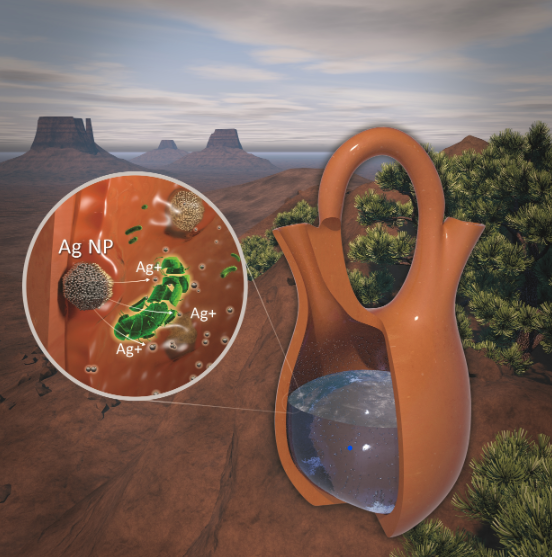A Sticky, Fragrant Solution to an Old Problem

A Sticky, Fragrant Solution to an Old Problem
While reading a new scholarly article on creating water filters from ceramic pots with nanoparticles of silver in them, I thought, I’ve read about this before; it’s not new. This type of system has been used in Africa and other disadvantaged areas that lack access to clean drinking water. In fact, the authors disclosed that “Using silver particles for water filtration is not the main innovation. Others have used this technology in the past. The key is controlling the release of nanoparticles, which can reduce the usable life of the filters.”
This filter has roots in proved science: that silver is antibacterial. Silver has positively charged ions that fight bacteria in three ways (check out our article to understand them). Silver nanoparticles can also penetrate through the bacterial biofilms (the slime that bacteria make to live on surfaces) to completely destroy them and can even prevent microbes from developing biofilms. (This is a great attribute for water pitchers, where standing water can allow biofilms to develop.)
So, the new part about this water pitcher/filter is what the silver nanoparticles are suspended in: pine resin. Apparently, pine resin is an old source of a “newer” category: polymers. Polymers have gained a lot of attention in the last few years because they have a lot of desirable properties such as versatility and durability. By definition, polymers are large molecules made by bonding (chemically linking) a series of building blocks. The word polymer comes from the Greek words for “many parts.” Each of those parts is scientists call a monomer (which in Greek means “one part”). (Explainer: What are polymers?) DNA and keratin (the material our hair and nails are made of) are natural polymers.
Pine resin is the hardened form of the sticky sap that runs out of pine trees when they are cut, but inside the tree it carries water, nutrients, sugar and mineral elements throughout tree trunks—similar to how blood functions in the human body. (5 Uses for Pine Sap: How to Harvest and Utilize Pine Resin)
Although it’s possible to get resin from the tree by cutting into it to harvest sap, this kind of damage can kill the tree. Otherwise, you can collect resin crystals that have formed on the outside of the tree from natural damage, heat them, and use the liquid resin for many means, such as firestarters (pine resin is high in turpenoids, the VOCs that make it smell like a pine tree), herbal remedies and soap, and natural glue.
This semi-solid, sticky nature of pine resin is also what makes it great for coating the inside of a water pitcher filter. Without it, the silver nanoparticles could react quickly to chemical impurities, which would make them unavailable for killing bacteria. The following diagram shows how silver nanoparticles embedded in the pine resin can be released more slowly to allow the pitcher to last longer as a filter.
(And, in fact, the other new part about this outreach was that the community in need of these filters is in the United States. According to this article from March 2023, the Navajo Nation reservation stretches across 27,000 square miles in Arizona, Utah and New Mexico. Fifteen to thirty percent of the 170,000 people who live there do not have access to clean, reliable drinking water. Although estimates vary according to the EPA vs. the tribe, it’s the “why” this continues…according to an EPA article, in 2003 the Navajo Nation estimated that up to 30% of the population did not have piped water to their homes. The EPA and HUD have worked to reduce this number, which they estimate has helped lower the percentage of the population without access to piped water to their homes to about 15%. Twenty years later, many must drive miles to haul water home or use unregulated water sources, which are susceptible to bacterial contamination and/or exceed drinking water standards for uranium and other chemicals, because some homes are located near abandoned uranium mines.)

Source: Pottery Becomes Water Treatment Device for Navajo Nation
Since the pottery and the resin are very natural elements that the Navajo respect and use, this type of filter could be very important to many in easing their burden of getting clean drinking water, and even after every home receives piped water (but given the history of this project, the “when” is not in sight). At HypoAir, we like natural elements too, so learning about the properties of a material that has been all around us for centuries is very exciting!

Photo by Jeremy Bishop on Unsplash






